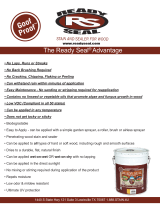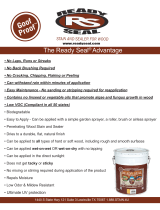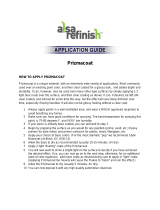
3
FINISHING AND REFINISHING INSTRUCTIONS
for Interior and Exterior Door Slabs and Systems (JCM004)
Doors to be Painted Doors to be Stained
Wood
(Authentic
Wood,
Premium
Composite
and
Molded)
1. Clean the door with a clean, lint-free cloth, removing all dust
and foreign debris. For light cleaning, a one part vinegar to
ten parts water mixture can be used. For tough dirt removal,
use denatured alcohol making sure all residue is removed
by turning the cloth often while cleaning. Allow the door to
drythoroughly.
2. Seal an un-primed door slab with a good quality water-
basedprimer.
3. Paint all sides of the door, jamb and molding with a good-quality
exterior water-based 100% acrylic latex or solvent-based paint.
Interior door or trim paint may be used on interior doors and
interior surfaces of exterior doors. Spray applications work best.
To simulate a traditional stile and rail door look when using a
paintbrush, paint the panels rst, then across all the rails from
one edge of the door to the other. Then paint the stiles from the
top of the door to the bottom. The door can also be rolled for a
stipple look. For best results, apply multiple light coats.
1. Clean the door with a clean, lint-free cloth, removing all dust
and foreign debris. For light cleaning, a one part vinegar to
ten parts water mixture can be used. For tough dirt removal,
use denatured alcohol making sure all residue is removed
by turning the cloth often while cleaning. Allow the door to
drythoroughly.
2. For un-primed units to be stained, we recommend applying
a pre-stain wood conditioner prior to staining to promote
a uniform appearance and avoid sharp color contrasts or a
blotchy appearance.
3. To add color after pre-stain conditioner, use an exterior oil-
based stain for the next coat.
4. Top coats may be an oil-based or water-based clear
polyurethane nish. A marine-grade varnish is recommended
on all exterior doors.
Steel 1. Clean the door with a clean, lint-free cloth, removing all dust
and foreign debris. For light cleaning, a one part vinegar to
ten parts water mixture can be used. For tough dirt removal,
use denatured alcohol making sure all residue is removed
by turning the cloth often while cleaning. Allow the door to
drythoroughly.
2. Lightly scuff and sand the door face and back (to improve paint
adhesion) and wipe the door clean with denatured alcohol. If
the door jamb and molding are primed, clean with a damp cloth
and allow to dry. Lightly sand any rough areas and re-clean.
3. Paint all sides of the door, jamb and molding with a good-quality
exterior water-based 100% acrylic latex or solvent-based paint.
Interior door or trim paint may be used on interior doors and
interior surfaces of exterior doors. Spray applications work best.
To simulate a traditional stile and rail door look when using a
paintbrush, paint the panels rst, then across all the rails from
one edge of the door to the other. Then paint the stiles from the
top of the door to the bottom. The door can also be rolled for a
stipple look. For best results, apply multiple light coats.
N/A
Grained
Fiberglass
(Design Pro)
1. Clean the door with a clean, lint-free cloth, removing all dust
and foreign debris with isopropyl alcohol making sure all
residue is removed by turning the cloth often while cleaning.
Allow the door to dry thoroughly. DO NOT USE SANDPAPER OR
LACQUER THINNER ON DESIGN PRO FIBERGLASS DOORS.
2. Paint all sides of the door, jamb and molding with a good-
quality exterior water-based 100% acrylic latex or solvent-based
paint. Interior door or trim paint may be used on interior doors
and interior surfaces of exterior doors. Spray applications work
best. To simulate a traditional stile and rail door look when
using a paintbrush, paint the panels rst, then across all the
rails from one edge of the door to the other. Then paint the
stiles from the top of the door to the bottom. The door can
also be rolled for a stipple look. For best results, apply multiple
lightcoats.
1. Clean the door with a clean, lint-free cloth, removing all dust
and foreign debris. For light cleaning, a one part vinegar to
ten parts water mixture can be used. For tough dirt removal,
use isopropyl alcohol making sure all residue is removed by
turning the cloth often while cleaning. Allow the door to
drythoroughly.
2. For the best results, we recommend using our Stain Kit and
included instructions. If not possible, use only a professional
quality, heavy body or highly viscous exterior gel stain. Apply
an even amount of stain with a foam brush or lint free cloth
in the direction of the wood grain.
3. Work the stain into the surface grain using a circular or cross
grain motion before nally wiping the stain in the direction
of the grain. For best results, apply stain to one section of the
door at a time, starting with the embossed panels rst and
proceeding with the at sections.
4. Before stain dries completely, wipe the surface in the
direction of the grain with a clean cheesecloth or rag to
remove any excess stain. Tip: Use a dry, soft natural bristle
brush to feather out lap marks and blend stain. Blot brush on
a dry cloth and feather stain until desired color isreached.
5. If a darker appearance is desired, apply a second coat after
the rst coat dries. Follow the manufacturer’s instructions to
apply and wipe the stain with a brush or rag. After one side
is stained and has completely dried, repeat staining process
on the remaining unstained sides of the door.
6. Allow stain to dry per manufacturer’s recommendations
(may take up to 48 hours). Spray on at least one coat of
clear exterior grade polyurethane. THE FIRST COAT MUST BE
SPRAYED ON. Additional coats may be sprayed or brushed on.
Repeat process on the remaining unnished sides of the door.









